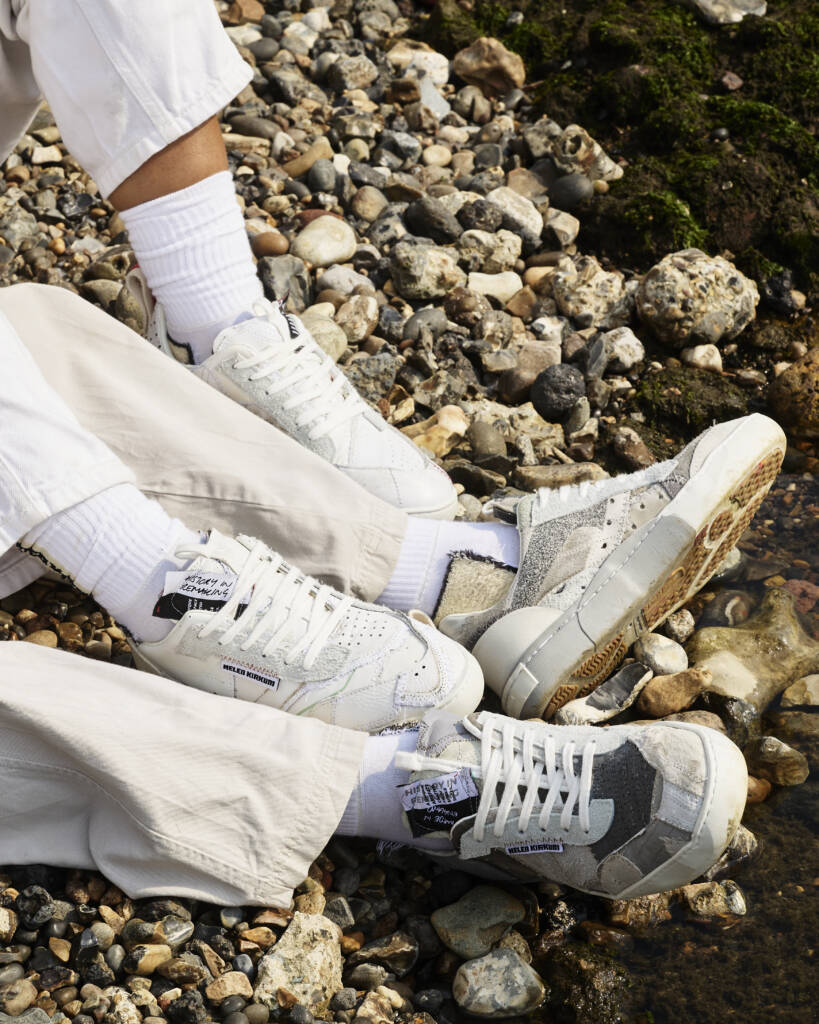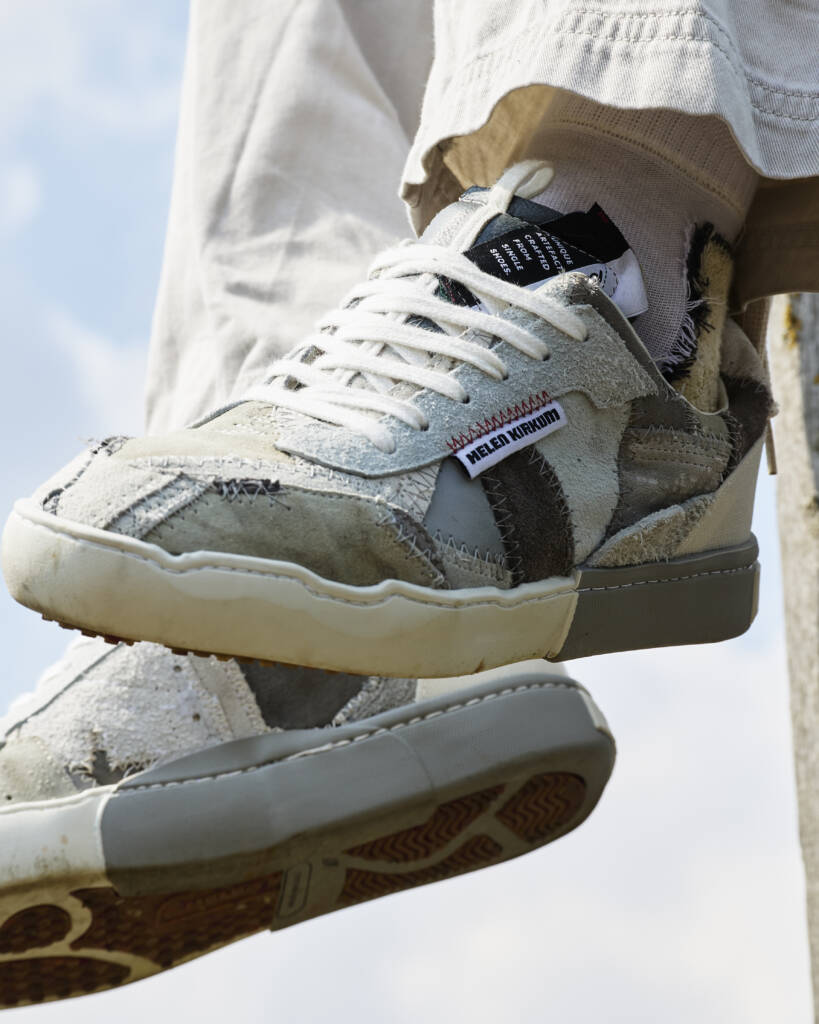
Photography by FRANCIS AUGUSTO



Ever wonder how a pair of worn-out sneakers can be transformed into something entirely new? In this interview, Helen Kirkum – who literally lets you build sneakers with her, from scratch – shares her unique process of reimagining sneakers as both personal keepsakes and fresh design statements. Her work is a bold contradiction: unfiltered yet thoughtful, blending raw materials with personal history to challenge the ordinary.
hube: Your Bespoke approach to reimagining old pairs of sneakers into something completely new turns worn, sentimental sneakers into entirely new designs. How do you balance preserving the emotional history of the original pairs while creating something so distinct that it feels like a fresh start?
Helen Kirkum: Bespoke is one of my absolute favourite things to do in the whole business because it is very personal to our clients. It all comes down to good communication with the client and understanding what they want. They send us up to six pairs of their shoes – these could be their first basketball shoes, the sneakers they got married in, or ones they ran a marathon in. Sometimes people just send us six pairs and say, ‘These are crazy, do what you like’.
But quite often, each pair is very personal. We listen to the stories behind their products – sometimes it’s a sentimental reason, sometimes it’s for a big birthday, a gift for someone else, or it marks a significant moment in their life. For instance, if somebody sends me an Air Max 95 and explains they wore them to a concert, I can extract those memories and put them back together. Every single customer is unique – the shoes and their stories are always different, and the anarchy of taking loads of brands, mashing them up, and rebuilding them feels fresh and unusual. It’s a way to honour the client’s relationship with their products while showing them how they can inject their personality into it.
h: Would you say that creating these shoes sometimes feels like connecting the past, present, and future – a timeline of personal milestones?
HK: Definitely. It is a signifier of all those moments. Every pair of shoes they give me comes from their life and marks different milestones. Then, whatever we create is for something current – like a 50th birthday – and after that, the reimagined shoe lives on in their collection. Some clients are very precious about them, hardly wear them, and keep them as their holy grails on the shelf. But I always try to encourage customers to wear the shoes so that they add more layers to the story, which I love.
h: Have you ever intended to create shoes that are purely art – pieces that just sit on a shelf – or is it always important that they remain wearable?
HK: It’s really important to me that they’re wearable because, although the concept is super conceptual and unusual, at the end of the day, a shoe has to function. To take all those pieces and put them into a product that you can’t wear just doesn’t make sense to me. I studied traditional shoemaking for a long time, and I’m a cobbler, so I know how to make a shoe well. For me, it’s about taking that traditional idea of shoemaking, modernising it, and adding these unusual twists. Sure, I can make unwearable artworks, but if I’m making a shoe, it’s got to be practical. It should be a shoe.
h: Transforming someone’s favourite sneakers into a singular new pair is a bold concept. How did you come up with this idea, and what’s the most surprising reaction you’ve had from a client when they saw their legacy sneakers reimagined for the first time?
HK: It’s kind of similar to the last point for me. I earned a Bachelor’s degree in footwear design in Northampton, the home of traditional footwear in the UK. There, I learned how to make a brogue very practically, working in a setting with the church’s factory, with brands like Cheney’s, Grenson, and other British powerhouses of footwear design. I learned how to make a good quality product and respect the process of making.
After my BA, I did a master’s degree at the Royal College of Art, and that’s where I first started delving into sneakers. I realised there’s something so sentimental about shoes in general, especially sneakers. When I started asking friends and family for their old shoes to cut up, everyone was so precious about their sneakers. Nobody wanted to give them up because they had such sentimental value. That got me on this path of exploring the emotional connection people have with products. Client reactions are always different. Sometimes, we only get a lovely email when a product arrives in Tokyo or New York, but when clients come to the studio, they’re often excited or even overwhelmed – it can be a very emotional experience. Whether it’s a present from their parents, a shoe made for a loved one, or a symbol of a significant life moment, seeing their shoes reassembled in that way is a once-in-a-lifetime product. We take it very seriously.
h: Your work involves breathing new life into end-of-life materials. Was there a moment when a piece of material surprised you or transformed your original concept?
HK: It’s really interesting because Bespoke work is a bit different – the shoes clients send in mean something to them, but our other products come from end-of-life materials that people no longer value, except maybe me. I remember a few years ago, I did a project for a Swiss museum exhibition on sneaker culture. They sent me loads of iconic sneakers from different years, and I cut them up and made them into a new shoe. That was the first time I understood the cultural value of the material beyond just the emotional connection. I had always been interested in the worn aesthetic and how material changes over time, but these were archive pieces. People would point out, ‘Oh, that’s from a Jordan 4 or an Air Max 1,’ and even the individual components had cultural significance. That project made me realise there’s another client out there for Bespoke work – not just sentimental products but also massive Nike collectors who want to see culturally relevant shoes combined in a certain way.
h: Working with archive pieces must be intimidating at times – so many valuable elements, and you have to create something new while preserving their essence. Was it difficult?
HK: Sometimes, I think the beauty of my work lies in my naivety toward the sneaker industry. I never came from a strict sneakerhead background; I approach sneakers as raw materials – shapes, colours, textures – rather than as these untouchable holy grails. That’s why some people might think my work is outrageous, asking, ‘How can you cut that up? How did you take that apart?’ I simply don’t overthink it – I just get my scalpel and go for it. I view the shoes as raw materials and not as sacred objects, and that allows me to work freely.
h: Sneakers have been your canvas, but if you were to reimagine your practice in another medium – perhaps furniture, art, or even tech – what would you create and why?
HK: I’m definitely keen to explore that. I’ve started dipping my toe into other projects. In our in-house production, we take old shoes and essentially create a fabric out of them, which we then use to make products. Now that we’ve mastered that technique, we can apply it elsewhere. I’m very interested in furniture and interiors – I’m passionate about interior design. For example, a few years ago, we made a lounge chair entirely out of insoles. Insoles, which are made of foam, aren’t suitable for wearable products, but they work brilliantly in furniture. It’s about extracting the elements we work with and finding a new industry where they make sense.

